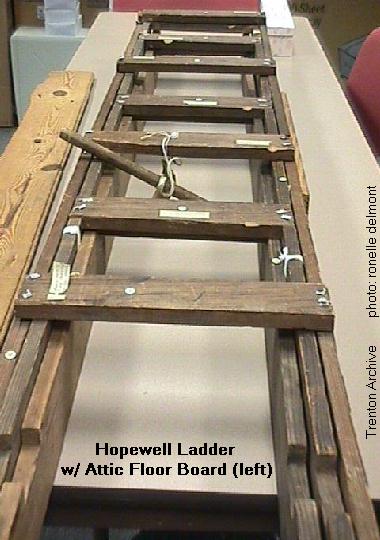
The Lindbergh Kidnapping Hoax
Who
Made The Ladder? 
WEBSITE
DIRECTORY ![]() SEARCH
THIS WEBSITE
SEARCH
THIS WEBSITE ![]() DONATE
with PAYPAL
DONATE
with PAYPAL
![]() SOURCES
SOURCES
![]() Ronelle Delmont's
Lindbergh Kidnapping Hoax
You Tube Channel
Ronelle Delmont's
Lindbergh Kidnapping Hoax
You Tube Channel
![]() Michael
Melsky's
Lindbergh Kidnapping Discussion Board
Michael
Melsky's
Lindbergh Kidnapping Discussion Board
![]() THE
KERAGA REPORT - pdf 35 pp.
THE
KERAGA REPORT - pdf 35 pp.
This 3-part, lightweight contraption was found about 50 yards away from the Hopewell nursery window on the evening of March 1, 1932. Two muddy holes beneath the nursery window led Police to believe it had been used to enter and exit from the child's bedroom.
Questions have recently been raised (from Police Reports found at the NJ Archive) as to whether or not those holes were actually DEEP enough in the wet soil for a person to have climbed up and down with a 30 pound baby. This ladder may have been a red herring after all.
Charles Lindbergh led the police to it in absolute darkness as soon as they arrived. How did he know the ladder was there if he had no batteries for his flashlight? (He supposedly sent Whately to town to buy batteries.)
ACME photographer, William B. Springfield took close-up photos only few hours later showing Mercer County prosecutor Marshall investigating the ladder with a magnifying glass.
Hundreds of hands touched this ladder by the time Hauptmann was arrested - 400 sets were discovered - but not a single fingerprint ever matched Hauptmann's! The chain of custody for this ladder could not even be established by the NJ Police but Judge Trenchard allowed it into evidence anyway. The NJ Police rebuilt several replicas to use in their re-enactments and not only could none of the cops get into the nursery easily but none were ever able to get out of the room via the ladder holding a 30 pound sack!
According
to reporter Laura Vitray in The Great Lindbergh Hullabaloo (1932)
"Most mysterious of all the clues in the kidnaping is that three-sectioned
ladder itself. The Colonel's conviction that it was used in the kidnaping
has been unreservedly endorsed by the New Jersey State Police, merely because
a trail of footprints were found leading from beneath the baby's window to
the spot where it had been dropped.
Yet it was such a ladder as is frequently used on construction jobs, and the
Conover Construction Company of Princeton, builders of the Lindbergh home,
admitted it was of lumber similar to that employed on various jobs by them.
Every expert who has ever examined it has agreed it was made by a master
carpenter, although in two of is sections the rungs were carefully mortised,
and in the third they were hastily nailed on. (page 47)
..It would not have been unusual if the ladder had been one that was lying
about the Lindbergh estate" (page 51)
(thanks to Sue Campbell for these excerpts)
The possibility is strong that this telescoping, lightweight ladder/plank was actually built by Charles Lindbergh - see why.
DNA analysis can now be done to determine whether or not the attic floorboard came from the same tree as Rail 16 of the "kidnap" ladder. In the meantime, (NJ Superintendent has not allowed any tests) Kelvin Keraga has been conducting non-invasive, non-destructive forensic tests at the NJ Archive under the supervision of Archivist, Mark Falzini.
Both pieces are on display at the W Trenton NJ State Police Archive which houses almost all of the trial evidence used to convict Richard Hauptmann.
The attic floorboard and ladder are the most important clues to the framing of the German carpenter. They were the ONLY pieces of evidence that could possibly have linked him to New Jersey and the dead child. The extortion money could easily have been, as Hauptmann always insisted, Fisch's money and does not in itself link him or even Fisch to the murder/kidnap - at least not after 2 years. That money could have been thoroughly laundered by September 1934.
If enough pressure is put upon the proper authorities this test could easily determine Hauptmann's innocence. It is the only hard evidence that exists - there were no fingerprints, no footprints that matched his shoes, and nothing to put him on a ladder in NJ at all. Unless, of course, the rehabilitated state witnesses and tampered time sheets can be believed.
Lt. Louis Bornmann moved into
Hauptmann's house after Anna and Bubi moved elsewhere. Bornmann later claimed to find
a missing floorboard in the attic. The attic had been repeatedly searched - 19
times - by 37 NYC and NJ cops. The FBI searched it as well. Nothing out of the
ordinary was found there until Lt. Bornmann made his "discovery."
![]() Read
Lt. Bornmann's testimony at Hauptmann's trial.
Read
Lt. Bornmann's testimony at Hauptmann's trial.
![]() Fulton
Oursler's account of the Attic Fiasco (PDF)
Fulton
Oursler's account of the Attic Fiasco (PDF)
photo at left was submitted to the LKH Public Forum by John Overall
Police spent lots of time investigating the ladder. The 3-piece ladder was shown to carpenters, neighbors, and even builders to examine. Pieces were analyzed to determine the type of wood.
Early in 1933, Arthur Koehler, (1885 - 1967) an employee of the U.S. Forestry Service in Wisconsin, looked at the wood used to build the ladder.
He took the ladder apart (click here to see his sketches) and examined all of the nail holes and hammer marks left on the wood. He believed some of the wood was used indoors prior to the building of the ladder.
Koehler said that the wood used to construct the ladder came from a multitude of types. He found the ladder to contain Pine from North Carolina, Douglas Fir from West of the Rockies, Birch, and Ponderosa Pine.
Koehler played a crucial part in convicting
Hauptmann. 
SOME UNEXPECTED APPLICATIONS OF SCIENCE
IN THE LINDBERG KIDNAP CASE
By
Arthur Koehler, In Charge,
Section of Silvicultural Relations
Forest Products Laboratory,1 Forest Service
U. S. Department of Agriculture
The interrelationship of the sciences with everyday affairs can be illustrated in numerous ways. One need only be reminded of such cases as the discovery of the now commercially important gas helium on the sun before its discovery on
this planet, and of the discovery of the extremely valuable x-rays while studying electrical discharges through gases of different kinds, to appreciate what a tremendous influence scientific work has on our well-being and progress.
I can cite several examples, although not so far-reaching in importance, from my own work in wood technology, which is the science that deals with the structure and properties of wood. For example, the observation that certain types of
abnormal wood shrink excessively along the grain, although in normal wood the longitudinal shrinkage is negligible, led to the discovery that there is a definite relationship between the degree of natural spiral twist that all wood
fibers have and the shrinkage along and across the grain -- as one increases the other decreases.
Later, when the Lindberg kidnap ladder was turned over to me for examination the question arose whether the 1 x 4-inch North Carolina pine uprights, or rails, in the bottom section of the ladder were originally planed to 3-5/8 or 3-3/4 inches
in width. The mill in South Carolina to which I had traced the rails made shipments of both widths and in order to follow the right shipments from that mill I had to know which of the two was the original size of the ladder rails.
When I first examined the ladder I found the rails measured more nearly 3-5/8 than 3-3/4 inches in width, in fact one end was nearly one-thirty-second inch scant of 3-5/8 inches and the other end was that much wider. The question was,
were the rails originally dressed to 3-3/4 inches in width and had shrunk subsequently or were they originally dressed to 3-5/8 inches with slight variation? The wider end, I noticed contained an abnormal type of wood that does not shrink as much across the grain as normal wood, whereas the other end was normal. The agreement in the differences in the width of the two ends with the
two types of wood therefore indicated that both had shrunk since manufacture and
since one end was still a trifle over 3-5/8 inches wide both must have been 3-3/4 inches wide originally. That made it possible to eliminate 18 shipments of lumber from the search and by following most of the other 45 shipments made from
the South Carolina mill during the 2-1/2 years preceding the kidnaping, one was found in the Bronx in New York City which showed exactly the same planing defects as the ladder rails and later proved to be the place where [Bruno] Hauptmann was employed before the
kidnaping.

Several other instances arose in the same case in which the science of wood technology was a valuable aid. For example, I noticed some faint irregularities of the edges of some of the ladder parts. The question was, were they due to the
natural raising of the grain, which frequently occurs in such low-grade lumber as was used in the ladder, or were they caused by tools or machinery? A previous study of grain raising in connection with wood finishing at the Forest Products
Laboratory and an intimate knowledge of the structure of wood in general made it possible to decide definitely that the fine ridges on the edge of some of the lumber in the ladder were due to planing with a dull hand plane that had nicks
in the cutting edge of the bit. A plane that made exactly the same series of ridges was found in Hauptmann's garage after his arrest, and a short piece of board with the same ridge marks was also found in his garage, although it was
not a piece left over from making the ladder.
Later, when it was discovered that a piece of lumber had been ripped from the attic of the house here Hauptmann lived, science again stepped in to prove that one of the ladder rails was made from the part of the floor board that had been
removed. Superficially there was nor resemblance between that ladder rail which appeared to be a 1 x 4-inch, square-edged board like the other ladder rails and the 1 x 6-inch tongued-and-grooved lumber used for the attic floor, except that
the two were the same type of lumber, namely, North Carolina pine. However, since the edges of that rail had been planed with a hand plane instead of by a machine it meant that it had been cut down from a wider board, presumably
tongued-and-grooved or ship-lapped since both edges were hand-planed. By smoothing off the end of the ladder rail and the end of the attic floor board from which a piece had been sawed off in the attic as indicated by the sawdust
on the floor and a shallow saw cut into the adjacent board, photographing the two ends, and superimposing half of the picture of the end of the ladder rail on the picture of the end of the floor board the perfect match of the annual rings
as to curvature, width, and irregularities could be demonstrated, leaving no doubt that the two at one time were one board. From a previous study of the relationship between the condition under which a tree grows and its structure it
was obvious that two trees could not conceivably grow under exactly the same conditions and produce the same pattern of growth rings for a period of 12 years, which was the number of growth rings present in the thickness of the boards. The perfect match of the rings in the ladder rail and the attic floor board therefore precluded any possibility of a mere accidental similarity
between the two.
![]() click
here to read Koehler's letter of request for reward money after Hauptmann was electrocuted
click
here to read Koehler's letter of request for reward money after Hauptmann was electrocuted
It seemed quite odd that Koehler claimed on the witness stand that the ladder was constructed by a professional. Why would the three section ladder not hold the weight of both the kidnapper and the baby if made by a knowledgeable person?
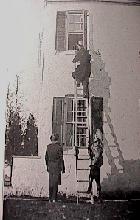 One of the strangest parts of the trial was that people believed the ladder had been used by Hauptmann because the rungs were constructed at an unusually wide 19 inches apart. An average ladder's rungs are only 12 inches apart. Hauptmann had long legs yet not a single person ever questioned the baby's father who had the longest legs of all! The famous aviator was quite familiar with the building of ladders, as well as other wooden objects, throughout his life.
He had attended the University of Wisconsin as a mechanical engineer major but
had been thrown out for poor grades.
One of the strangest parts of the trial was that people believed the ladder had been used by Hauptmann because the rungs were constructed at an unusually wide 19 inches apart. An average ladder's rungs are only 12 inches apart. Hauptmann had long legs yet not a single person ever questioned the baby's father who had the longest legs of all! The famous aviator was quite familiar with the building of ladders, as well as other wooden objects, throughout his life.
He had attended the University of Wisconsin as a mechanical engineer major but
had been thrown out for poor grades.
Koehler later claimed that the nail holes of a board used to make the ladder matched the holes in a board in Hauptmann's attic. This added to the Prosecution's "evidence."
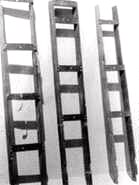 However many hours Koehler put into investigating the ladder, some discredited his examination of the ladder. The ladder, with hundreds of sets of fingerprints on it - not a smidgen of which were Hauptmann's - had been in many hands.
However many hours Koehler put into investigating the ladder, some discredited his examination of the ladder. The ladder, with hundreds of sets of fingerprints on it - not a smidgen of which were Hauptmann's - had been in many hands.
![]() read a 1998 Boston Globe article about wood
evidence at Hauptmann's trial
read a 1998 Boston Globe article about wood
evidence at Hauptmann's trial
Ewald Mielke, owner of a millworking plant, said that the two boards, one from the ladder, the other from Hauptmann's attic, were not the same. Dr. Erastus Mead Hudson even claimed that the piece of wood he investigated before only had one nail hole- not the four holes it had during the trial. He believed that the police put new holes in the wood or that the wood was not the same piece. Charles De Bisschop testified that wood was all the same and therefore Koehler would find similarities between the wood used in Hauptmann's attic and the wood used in constructing the kidnap ladder.
South Bay News
Bygone Days - Dec 3, 2003
thanks to Sue Campbell for this story
http://www.southbaynews.com/news/2003/1203/Columns/011.html
In recent months, newspapers have printed a number of articles about the kidnapping of children.
How many of my readers remember the kidnapping and murder of the 20-month-old son of famed aviator Charles A. Lindbergh and his wife, Anne, on March 1, 1932--and the "Trial of the Century" when, three years later, Bruno Richard Hauptmann was found guilty of the kidnapping and murder of the Lindbergh baby.
And what has this tragedy got to do with our village history?
A Lindenhurst resident named Ewald J.H. Mielke became interested in the case when, according to Mr. Mielke, "an outstanding columnist wrote gross misstatements in a current magazine". Mr. Mielke wrote a letter to Edward J. Reilly, chief counsel for the defense, informing him of his concerns.
Subsequently, Mr. Mielke received a letter from Mr. Reilly, calling him to his office at 26 Court Street in Brooklyn to study facsimiles of the kidnapping notes alleged to have been written by Hauptmann.
At the trial, Mr. Mielke took the stand and was questioned about the handwriting in the kidnapper's note. Since Mr. Mielke was a "carpenter with long and practical experience and knowledge of lumber of every grade", he was also questioned for about 20 minutes with regards to the "wood taken from the ladder used in the kidnapping".
Bruno Richard Hauptmann was found guilty on February 13, 1935 after a six-week trial. After a number of delays, he was executed on April 3, 1936 in the electric chair in Trenton, New Jersey
![]() click
here for Ellis Parker's unanswered questions about the ladder
click
here for Ellis Parker's unanswered questions about the ladder
Why Lindbergh May Have Built This Ladder
Reeve Lindbergh mentions, in her memoir "Under A Wing," while looking at the Sirius in the Smithsonian with her mother, how difficult her entry to the Sirius must have been. Especially since Anne was 7 months pregnant at the time of their first flight (California - New York.)
The
Sirius would
later be fitted with pontoons making entry extremely difficult for
a short woman.
Anne
told her daughter "But your father made me a little
ladder!"
Because of the odd way in which this collapsible ladder was built - with flat pieces of wood nailed over both side rails - it could actually have been a homemade contraption (Lindbergh thought of himself as an inventor) meant for more than a single purpose
a) Anne's entry into the cockpit
b) a gangplank for the Sirius when it landed in mud (Anne has descriptions of muddy landings in some of her diaries)
Notice the example in the Corbis.Com photo below.
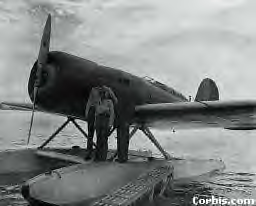 The
extremely low weight - only 38 pounds -
is another indication of Lindbergh's handiwork since he was obsessed with
the weight of everything he brought on board. (He even cut the margins off maps
to save weight.)
The
extremely low weight - only 38 pounds -
is another indication of Lindbergh's handiwork since he was obsessed with
the weight of everything he brought on board. (He even cut the margins off maps
to save weight.)
The telescoping aspect of this ladder also fits this theory since it could then, in collapsed form, easily fit inside a small storage bin onboard any plane.
This ladder, as a kidnap ladder built for the Hopewell house, makes no sense since it is too short for any window using 2 pieces and too high using 3 pieces. The dimensions DO NOT match the Hopewell house at all.
It was obviously NEVER built with the nursery window in mind. The dimensions are all wrong when measured against the house
But,
when lying
flat on the ground, or extended from the cockpit of a pontooned aircraft. It
would have been an ideal gangplank. The large spacing of the rungs - 19 inches
apart - has always been attributed to a long-legged builder and a horizontal
gangplank would require those bigger spaces.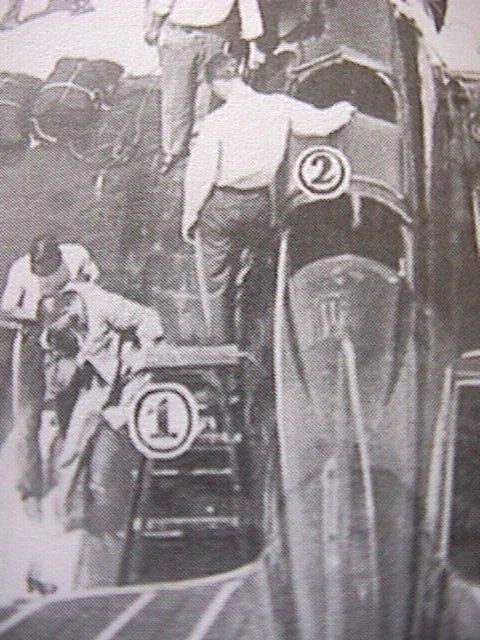
Also important to note - it was established at Hauptmann's trial that the basement of High Fields was stacked with unused lumber. And, over by the shed - on the far western edge of the house - stood such a huge pile of used lumber that it can be seen in aerial photos at the time. The home was still partially under construction.
Posts from the LKH Public Forum
Ralph
DNA, Koehler and other acts from the tree ring circus
5/10/99
As the story goes when the Pope was investigating Galileo
for heresy for audaciously claiming that the earth went around the sun Galileo invited the Pope to his house to
demonstrate his theory. Once there Galileo invited the Pope to look into his "telescope" to see for himself. The Pope
refused, saying, "I will not look into that telescope. I do not need to look into it. The Church's greatest theologians and scientists have decreed that the sun goes around the
earth and therefore there is no need for me to look into that 'devil tube'."
I don't know if the story is true, a product of Bertolt
Brecht's over-active imagination, or merely some urban legend which has grown over the years, but I have been
recently reminded of the story by the reaction of some on this Board to the notion that DNA testing could and should
determine, once and for all, whether "the ladder"
(are any other descriptive words necessary for this object?) came from the attic of you-know-who. Such a scientific approach is rejected here either because it is
1) too expensive
and
2) not necessary because in 1935 Arthur Koehler testified that the two boards were once joined and no "expert" has
since ever disputed that and what more needs to be said?.
The modern day "Act of Faith" exhibited by those who hold to this position, and who would gladly again strap Bruno
Richard Hauptmann into the electric chair, rivals the faith of any ancient Papal pronouncement.
However, heretic that I am, I still would like to know several things.
First, what other experts?
In a recent post JM hinted (unless I misread him) that a recent expert examined the hair samples and ladder rail and floor board
and came to the same conclusion as had the 1935 jury: namely
that 1) the dead child was the Eaglet and 2)that the boards were once joined. Although I am not concerned with whether
the dead child was the Eaglet, and tend to think it was
(sorry David, can we still do lunch?) I am curious as to what modern experts have confirmed Koehler, and more
importantly, what type of scientific analysis was used.
Was it chemical? Was destructive testing necessary? Or, was
it, as I fear, that someone looked at it in say, 1982 and said, "Yeah, it looks to me like these were once one board." Because ultimately. that's all there is to Arthur Koehler's original "expert" opinion.
I have posted elsewhere my opinion that Arthur Koehler would not be allowed to even render such an opinion today.
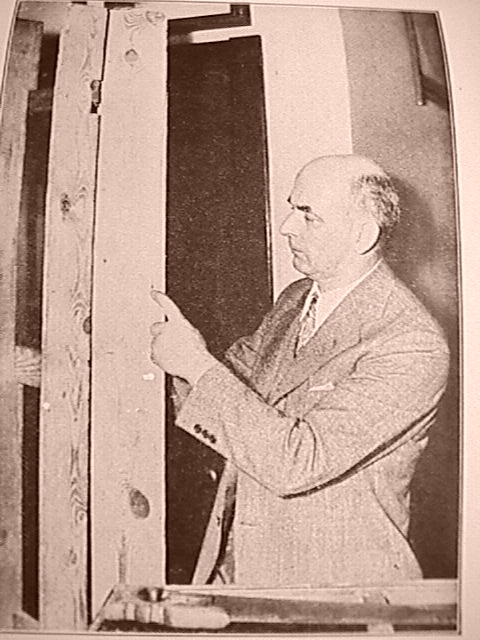
We can nit-pick all we want whether Frye is good law, whether, as JM maintains, the Federal Rules of Evidence
would somehow apply to this State Court murder prosecution
(in fairness to JM I suppose his argument would really be that the State Court equivalent of the FREs would apply) but
the bottom line is that there would be a pre-trial hearing
at which Arthur Koehler's "science", as well as his own credentials to render such an expert opinion, would be
challenged. There is no doubt in my alleged mind that the
prosecution would come up short on both counts. (I use the words "alleged mind" because others on this board have
described my thoughts as insane).
Several on this Board have analogized what Arthur Koehler did in 1935 with fingerprint analysis. Don't be
easily fooled on that one. A "fingerprint expert" is trained to look at a subject's undisputed fingerprint, and a
suspect sample, and determine if they match. That it is
unlikely that two fingerprints are identical is a scientific truism which underlies the process. But it only starts
there. The fingerprint expert then spends countless training sessions studying and comparing known test samples.
These known test samples are known to either be, or not be,
matches, and therefore the student's abilities can be objectively quantified. Certain points are looked for and
the more "points" one finds the greater likelihood of a match. It is only after this training and practice that the
prospective fingerprint expert is certified and allowed to
go into court to render an opinion in a criminal case. What evidence is there that Arthur Koehler's job (or training, or
experience, or even weekend hobby) was to look at two boards and to try and determine if he could accurately ascertain that they had ever been joined?
None.
Whether you call him
a forester, a wood expert, or whatever, that was not his
job, and he had NO experience in doing that. His opinion that they were once joined is no more "expert" than David
Sims' opinion that it doesn't appear to be so. Sorry Dave, but I question whether either one of you would be allowed
into the modern day Hauptmann trial.
But it is even worse for Koehler's theory. With fingerprint analysis a positive match means that the expert
is LOOKING AT THE EXACT SAME PRINT. The print of the right thumb is the same print of a right thumb found on the window sill, etc. In Koehler's case the attic board which he was
comparing was not the same board as rail 16, he was not looking for a "match", rather he was looking at the attic board and saying that the knot grain, if continued out,
would have continued into the pattern found in the attic board. And he was opining this despite the missing intervening piece.
It's good to know that Faith is alive and well, but I question it's role in any modern day analysis of this
baby disappearance.
Let's do the DNA testing. Let's look into the telescope.
Richard Sloan
Inside Bruno's house
Tue Aug 14 2001
You ask what's the response when people ask to see the inter. of his house. I stood outside many times over a period of a couple of yrs, while making a very
amateur video documentary (I'm almost finished with the shooting, but have tons of work to do on the
editing! )I saw the owner outside a few times, and finally we started waving to
each other. "WOW!", I thought. This is step one in getting to ask if I can go inside."
Eventually, on another visit, I told him I'd love to see the inside of the house. But he said that the house belongs to his mother, and that he and his wife merely rent from
her. (I forget how long he's been there.) He said that his mom won't even think about letting strangers into the house, under any circumstances. They all know about its notoriety. But I once showed him a photo of the kitchen and pantry and he said the icebox was replaced by a tall refrigerator and that the upper wall cabinets are therefore gone. The pantry in the photo is still there! However, a modern sink and counter now extends to the middle of the pantry so that only the top half of the pantry and door still exist.
I remember reading that Hauptmann (or someone else) once said that he had thought Foley was asking him about writing in the kitchen closet, where they kept newspapers before throwing them out, not his son's closet. I asked the owner if there is a closet in the kitchen. He said there isn't; there isn't any room for one. Nearest closet is just outside the kitchen, in the hallway, which once led up to the attic. He knew that,
because it was the only way into the attic when he moved in. But he closed up the ceiling of the closet and installed a pull-down staircase, a couple of feet further down the hall. He said the attic is piled high from one end to the other with all sorts of junk.
I also asked him if there's a narrow closet in the small bedroom, pointing up, from the side of the house where we stood, to where I thought it would be, based upon a drawing I found in an old scrapbook. He said I was right; that's his daughter's bedroom, and there is, indeed, a narrow closet in her room. I don't recall going into details about the significance of the closet.) I do remember telling him that Hauptmann and his wife and child also lived upstairs, like him, and rented the upstairs, just like him!
I relate this information during my tours.
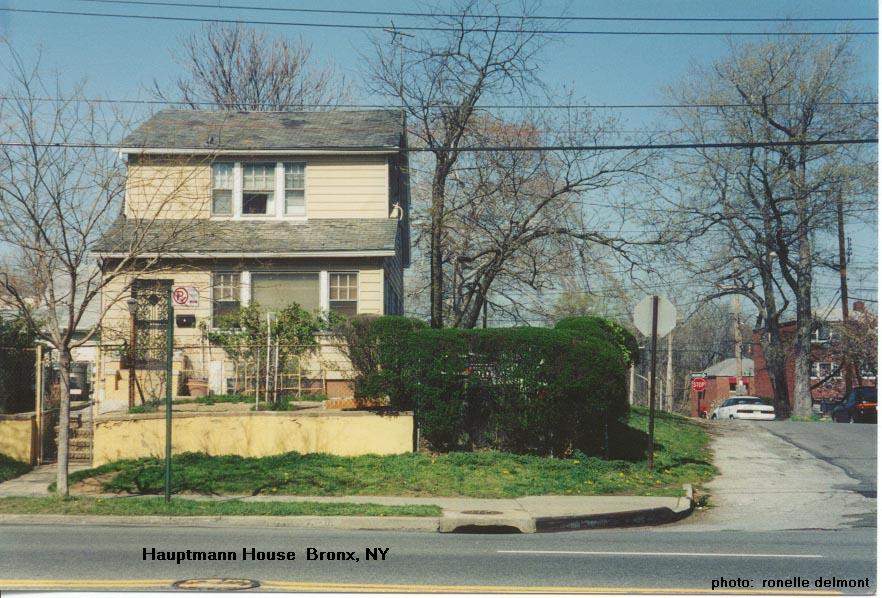
Michael
Melsky
Ladder Mystery (1)
Mon Jan 21 22:51:35 2002
Ladder Maker and Construction
Memo to Schwarzkopf from Squire
Johnson,
Asst. Director of Construction Division of Architecture & Construction
3-10-32:
Indications are that this ladder was constructed by two different persons. The
two smaller portions, in my opinion, were constructed by two different persons.
The two smaller portions, in my opinion, were constructed by a left handed
person, inasmuch as the saw cuts on the rungs of these two sections, by virtue of
the splintering or break which occurs at the bottom of every saw cut, indicate
that they were sawn by a person who wielded the saw with his or her left hand.
The large section does not show such indications and the rungs were sawn by a
keener saw than was used on the two smaller sections. With the exception of one
runner piece which bears indications of having been sawn with a rip saw and then
planed,....
....The ladder is not well made. It seems to be the product of a person who is
perfectly familiar with wood working details but who has had no training in such
work. The angle of the nails driven through the rungs into the large section of
the ladder alone indicates this, as also does the distance between the rungs of
all sections of the ladder. The relation of the angle of the saw cut to the
machine evened edges of the rungs on the two smaller sections of the ladder
further indicates that these cuts were made by a left handed person....
N.Y. File 62-3057 page 104:
Marks on the Lindbergh house and on the ground adjacent, indicated that the
ladder rested to the right of the nursery window entered by the kidnappers, the
bottom shafts leaving impressions 11/2" deep, about 3' out from building.
The location of those marks suggests the possibility that the kidnapper might
have been left-handed.
Vitray page 49:
In the red clay mud under the nursery window three small holes, not more than an
inch deep, marked where the ladder had stood. The center one was a trifle larger
than the other two, indicating that it had first been placed in the center below
the window, and then moved over a little, the right leg accidentally resting in
the hole that had already been made by the left.
March 2, 1932 NYTIMES:
Then the flimsy home-made ladder, which the kidnapper used to climb into the
baby's room where he lay asleep, came in for closer attention.
A&M 121:
Koehler decided immediately that the carpentry work was sloppy, and noted that
it (ladder) had crosspaced inset of rungs, notched unevenly into the side rails.
Vitray 47:
I have been assured by those who tested it that it could not bear a weight of
more than 125 pounds.
Jersey Troopers by Leo J Coakley p121:
State Police carpenter's had built ladders identical to the kidnap ladder
N.Y. File 62-3057 page 101:
Tests were conducted by the New Jersey State Police to determine what weight the
ladder would hold, and the consensus of opinion among a number of the officers
present at the test, was that the ladder would not hold a weight much over one
hundred and twenty-five pounds.
Hauptmann's letter to his mother Dec 27, 1935:
But the most ridiculous thing about the whole ladder, is that it is altogether
no ladder. It is only a wooden rack and I do not believe even now that this rack
was ever used as a ladder. Its construction shows too plainly that it never came
from the hand of a carpenter, no not even from a poor one. The prosecutor said,
to wit, that I am not a good carpenter. I say, herewith, only that I have often
worked for myself and as a foreman. Every master could depend on me. Indeed, I
often had to figure out the whole requirement of wood for a new construction and
order material and was also responsible for the whole job.
1. Hauptmann was right-handed
2. Hauptmann was a skilled Union Carpenter
3. Hauptmann weighed 180 pounds
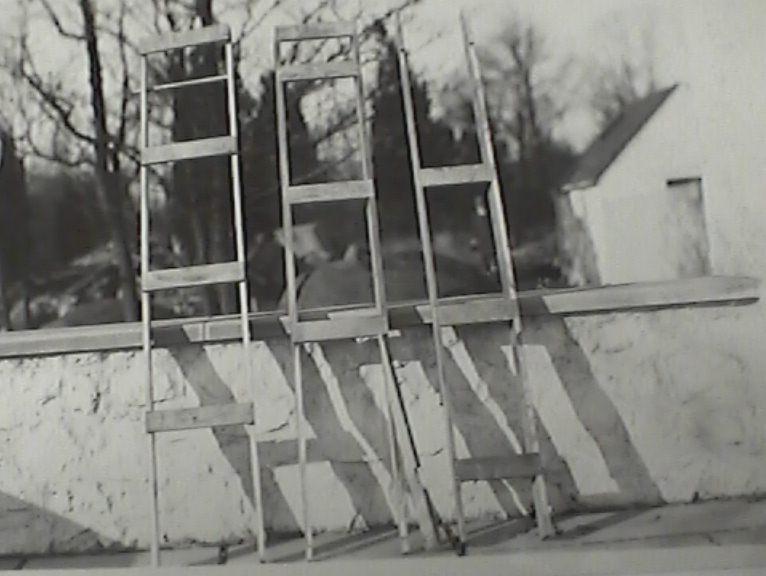
LADDER TESTIMONY AT FLEMINGTON
Michael Melsky
The PROPosition Suspicion
Sun Mar 3 2002
Please visit :
![]() Ronelle Delmont's
Lindbergh Kidnapping Hoax
You Tube Channel
Ronelle Delmont's
Lindbergh Kidnapping Hoax
You Tube Channel
![]() Michael
Melsky's
Lindbergh Kidnapping Discussion Board
Michael
Melsky's
Lindbergh Kidnapping Discussion Board
WEBSITE
DIRECTORY ![]() SEARCH
THIS WEBSITE
SEARCH
THIS WEBSITE ![]() DONATE
with PAYPAL
DONATE
with PAYPAL
![]() SOURCES
SOURCES
© Copyright Lindbergh Kidnapping Hoax 1998 - 2025